Van Gogh Museum Journal 1997-1998
(1998)– [tijdschrift] Van Gogh Museum Journal–
[pagina 68]
| |
 fig. 1
Vincent van Gogh, Plaster statuette of a horse, spring 1886 (F216c JH 1082), Amsterdam, Van Gogh Museum (Vincent van Gogh Foundation) | |
[pagina 69]
| |
Van Gogh's plaster models examined and restored
| |
Van Gogh at Cormon's studioDespite his original intention to join an art school as soon as possible after arriving in Paris, it was probably only some weeks later that Van Gogh actually entered a studio. As he wrote to the Belgian painter Horace Livens, he did not ‘have enough money for models’ [572/459a]; the only solution was to go to the atelier of an established artist, where he would be able to make drawings from the nude for a relatively small fee, and obtain a master's opinion of his attempts.Ga naar voetnoot1 It was probably in the spring of 1886 that he enrolled at the private art school of Fernand-Anne Piestre, also known as Cormon, whose studio on the Boulevard de Clichy was already known to him from various Dutch painters back home in the Netherlands. How long he actually worked there is not known.Ga naar voetnoot2 In the letter to Livens, probably from the late summer of 1886, Van Gogh stated: ‘I was in Cormon's studio for three or four months, but I did not find it as useful as I had expected. It may be my fault, however. Anyway, I left there, too, as I left Antwerp, and since then I have worked alone, and fancy that I feel my own self more.’Ga naar voetnoot3 Cormon was a history painter and he ‘would certainly [have been] able to teach Van Gogh how to work in a conventional, craftsmanlike manner and still attract attention.’Ga naar voetnoot4 On account of his age, his appearance and his attitude towards studio painting, however, Van Gogh was an outsider even to his fellow pupils. His only close contacts were with Louis Anquetin, Emile Bernard and the master-class pupil Henri de Toulouse-Lautrec. He frequently discussed art theory with them - an activity that often seemed more important to him than painting after plaster casts. Nonetheless, some of these paintings have survived: a female torso on an Attic base, of which Van Gogh painted five different versions;Ga naar voetnoot5 a female torso,Ga naar voetnoot6 with its right leg resting on a pedestal curved in the fashion of a cornice; the torso of an athleteGa naar voetnoot7; a horse (fig. 1);Ga naar voetnoot8 and a kneeling man (fig. 2).Ga naar voetnoot9 After leaving Cormon's, plaster models seem to have ceased to be a relevant topic for him; only a painting of a female torso on a fabric-covered surface, from the winter of 1887-88, has survived (fig. 3).Ga naar voetnoot10 | |
[pagina 70]
| |
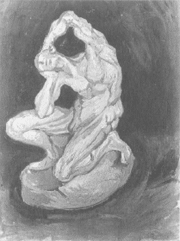 fig. 2
Plaster statuette of a kneeling man, spring 1886 (F 216F JH 1076), Amsterdam, Van Gogh Museum (Vincent van Gogh Foundation) 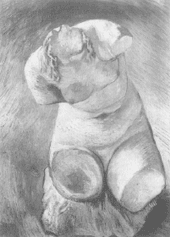 fig. 3
Plaster statuette of a female torso, seen from the front, winter 1887-88 (F 216 JH 1348), Tokyo, private collection   figs. 4-5
Plaster model of the horse before and after restoration | |
The plaster horse and the kneeling manVan Gogh painted after the plaster horse in the spring of 1886 in oil on cardboard, mounted on plywood (fig. 1). The painting is very small: a mere 33 x 41 cm.Ga naar voetnoot11 The trotting horse depicted in the painting is similar in size to the original model (about 25 cm high and 30 cm wide). Prior to its restoration, the plaster model was in very poor condition (figs. 4 and 5). All four legs were badly damaged and partly missing, the base was broken in the middle, and the tail and left ear had vanished. The outlines of the legs could be roughly surmised from the shape of the reinforcement wires. Reconstruction was complicated, as there was no completely authentic model.Ga naar voetnoot12 Van Gogh's painting shows part of the shape of the legs and musculature. However, his outlines in the lower leg area are very imprecise and were of little use in the restoration. The right foreleg strides out further in the model than in the painting. The left rear leg is more acutely angled in the painted work, and the right rear hock is more pointed than in the plaster model. It was finally possible to determine what shape the reconstruction should take on the basis of the variations between the final painting and its underlying preliminary sketch. The sketch shows a broad, bushy tail, which Van Gogh subsequently corrected. The model still had the original front right hoof, quite flat and out of proportion. In the painting it has been enlarged in umber, with the additional area appearing as part of the hoof. In contrast to the other three hooves, here the artist has evidently made an addition of his own to the model. The fact that the wire reinforcement of the left rear leg extends into the base indicates that there must have been some object under the raised hoof which does not appear in the painting. There was a fracture in the base underneath the hoof. Following the restoration, the model was retouched. The Van Gogh Museum owns another plaster model after which Van Gogh painted during his time in Cormon's studio (fig. 2). This is the model of a muscular nude man, squatting on a low, polygonal seat (figs. 6 and 7). | |
[pagina 71]
| |
 figs. 6-7
Plaster model of the kneeling man before and after restoration This cast was not as badly damaged as the horse; only the left arm was missing. Reconstruction was relatively simple, thanks to a completely identical plaster model acquired by the museum. The only difference between this model and the one from which Van Gogh painted is that it was covered with a brownish coat of paint. The existence of this identical cast made it an easy matter to reconstruct the missing arm. | |
The female torsoThe third figure used by Van Gogh was a plaster female torso, about 60 cm high (figs. 8 and 9). He is thought to have painted the picture after it (fig. 3) in the winter of 1887-88. It is 73 x 54 cm in size, which is relatively large for a Van Gogh painting. The model is viewed from above, and the artist has painted the torso with great precision. The shadow cast by the light from the left emphasises the curves of the body. The remains of curly hair falling over the shoulders are more plastic in the painting than in the cast. In contrast to Van Gogh's other paintings after plaster models, the figure's contours are clearly defined; only the cushion is a little unclear. The preliminary sketches, which still show through in the paintings of the horse and the athlete, are no longer visible here. The background changes from a vigorous yellow at the bottom of the picture to a lighter yellow in the middle, and then to an increasingly blue colour towards the top. To the right of the figure there is a smooth blending of colour. Before the restoration, the cushion was completely broken off below the right thigh, and a small part of the | |
[pagina 72]
| |
 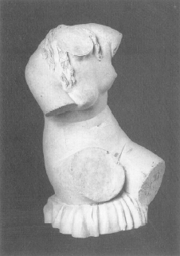 figs. 8-9
Plaster model of the female torso before and after restoration hair on the right collar-bone was also missing. The absence of the right-hand part of the cushion meant that the torso could no longer stand upright. The depiction of the folds in Van Gogh's painting, however, made it possible to achieve an almost completely authentic reconstruction. The missing piece of the cushion was recreated in plaster, and the torso can now once again stand erect. | |
Other castsIn addition to the three plaster figures Van Gogh used as models for his paintings, the Van Gogh Museum owns several others after which no paintings appear to exist. All of these casts were in need of some attention. The death mask of Dante (fig. 10), for example, originally painted but covered with a greyish-brown layer of dirt, needed to be cleaned. There was also some minor flaking and scratching all over the surface. The model itself, however, was undamaged, and did not require any reconstruction or reinforcement. The colour of the headgear could eventually be identified as a dark reddish-brown. A small paper label indicating the name of the gallery from which the cast was purchased is still glued to the inside of the mask. It reads: ‘Articles de Peinture - L. Latquche - 34, r. de Lafayette.’ This gives a clue to the mask's origin, but does not tell us whether either Vincent or Theo van Gogh acquired it themselves, or whether Vincent ever painted from it. In view of its relatively good condition, the mask was simply cleaned mechanically, using fine brushes and a soft eraser so as not to damage the original surface. Badly soiled parts such as the eyes, nose and mouth were also cleaned with a pH-neutral soap. After cleaning, the mask was coated with a protective varnish to prevent further dirtying. The Van Gogh Museum also owns a cast of a young woman's face with closed eyes (fig. 11), probably also a death mask. This piece was originally a greyish-brown colour. Before restoration there was a crack on the left-hand side of the face, running from the left ear across the cheek to the corner of the mouth and up to the cheek-bone. The surface displayed flaking and fine cracks. The mask was covered with a thin layer of dirt that concealed most of this surface damage. This indicates that the damage itself was probably older. Due to the crack across the left cheek, the mask was in danger of fracturing; synthetic resin and reinforcement strips were thus applied to the back to strengthen it. On the surface, however, the crack | |
[pagina 73]
| |
 fig. 10
Plaster death mask of Dante after cleaning was left untreated. Following this reinforcement the mask was cleaned, retouched, and coated with a protective layer of varnish. There is likewise no evidence that Van Gogh ever painted after the statue of a nude young man - a Slave after Michelangelo - also in the collection (figs. 12 and 13). Technically, this figure was in good condition. A glued join can be seen above the bent left knee. The base has been restored under the ball of the foot. The figure, which was originally painted white, was covered with a thin layer of dirt and had become very grey. Like the other casts, it was mechanically cleaned and then retouched. The seventh model to undergo restoration was the Bust of a man (fig. 14). This model was badly damaged. The left shoulder, the pedestal, and the mount were all missing. The shoulder was recreated in plaster, as were missing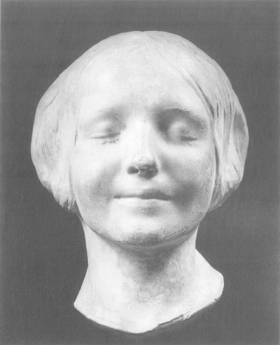 fig. 11
Plaster mask of a woman's face after cleaning and restoration parts of the moustache. The neck has a cylindrical depression into which a mounting rod can be inserted, and a replacement rod was made out of high-grade steel. To ensure firm anchorage, a plaster wedge was fitted to the upper end of the steel rod, completely filling the hole in the neck and so providing an ideal mount. The steel rod was glued into the pedestal, which is made of polished natural stone. The surface, which was reasonably clean, had been coated with a layer of yellowish-green paint. As with the other casts, it was mechanically cleaned. Finally, the reconstructed parts were colour-matched to the original. | |
Further analysesPaint analysis was carried out on three of the models: the horse, the female torso, and the statuette of the young man. The purpose was to determine whether white | |
[pagina 74]
| |
 lead had been applied to all the casts, and which pigments were present in the dab of green paint on the horse's left flank. It was found that white lead had indeed been used as a base substance, together with a number of adjuvants. The green paint turned out to consist of cadmium yellow, chrome yellow, zinc yellow and viridian. | |
Van Gogh and the classical traditionAs noted above, there are no paintings in Van Gogh's oeuvre after the death masks of Dante and the young woman, the Michaelangelo statuette, or the bust of the moustachioed man. It is no longer possible to tell whether the casts were already in the Van Gogh brothers' possession in Vincent and Theo's day, or whether they were purchased later. As Vincent often gave away, destroyed or painted over his pictures, there is also no way of knowing whether or not he ever painted after them. In his letters, Van Gogh rarely mentioned the fact that he had painted after classical models. He wrote to Theo from Antwerp, for example: ‘For speaking of Cormon, figs. 12-13
Plaster cast of Michelangelo's Slave befor and after restoration I think he would tell me much the same thing as Verlat, namely that I must draw from the nude or from plaster casts for a year, just because I have always drawn from life’ [560/449].Ga naar voetnoot13 In letter 563/452 he told Theo that he had not yet solved the problem of how to draw from the antique, but that he was developing a better feel for it and would keep up his efforts. In the same letter he refers to the urgent need to produce studies after classical models once he is in Paris. At the end of letter 566/455 he mentions that he is currently working on a female torso, and reiterates his plan to move to Paris: ‘So there is no choice; besides, what need is there to choose? For what is most pressing must come first, and that is the period of drawing from the nude and the works of antiquity.’Ga naar voetnoot14 His acquaintances described him painting from plaster figures in the classical style. Emile Bernard recalled | |
[pagina 75]
| |
later: ‘I see Vincent again at Cormon's, in the afternoon, when - without its students - the studio became a kind of cell for him. Standing in front of an ancient plaster cast, he copies the beautiful shapes with the patience of an angel. He wants to master these contours, these dimensions, these reliefs. He corrects his work, starts again with enthusiasm, and ends up making holes in his paper and destroying it with his erasures. Faced with this Latin marvel, which resists him to the end, in his own Dutch way he does not doubt for a minute that he will succeed in conquering it; but he was to find his way much better and sooner in the freer fantasy and light lyricism of impressionism than in this calm perfection, revealed to serener men and civilisations closer to nature and more adapted to thought.’Ga naar voetnoot15 While the pictures Van Gogh painted after plaster casts are not necessarily among his most important, they do reflect the phase that marks the beginning of the work which was later to make him famous. As the extracts from his letters indicate, his move to Paris was preceded by a period in which he showed great interest in drawing after classical models. Cormon's studio played a decisive role in this process, even while Van Gogh was still in Antwerp, and made it easier for him to leave. It is not known why the artist later also left Cormon's studio. Probably during the summer months he simply preferred painting out of doors to sitting in a studio making studies of casts. 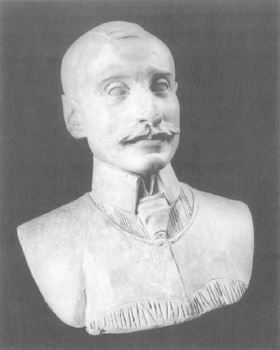 fig. 14
The Bust of a man after restoration |
|

